
Costaria costata
Five-ribbed Kelp, Seersucker Kelp
Interacted with at Gonzales Bay, Juan de Fuca Strait, Victoria, British Columbia, Canada
2 April 2021
Time at site: 14:05 to 15:10 PST
Low tide 1.6 ft at 14:12 PST
Weather: Mostly cloudy, no precipitation, wind SE 15km/hour, sea light chop, temperature 10˚C, relative humidity 70%.
Phase of Moon: Waning Gibbous (approx. 122 hours into this phase at time of observation); (Previous Phase, Full Moon, 28 Mar 2021 at 11:48 am PDT: Next Phase, Third Quarter, 4 April 2021 at 3:02 am PDT.)
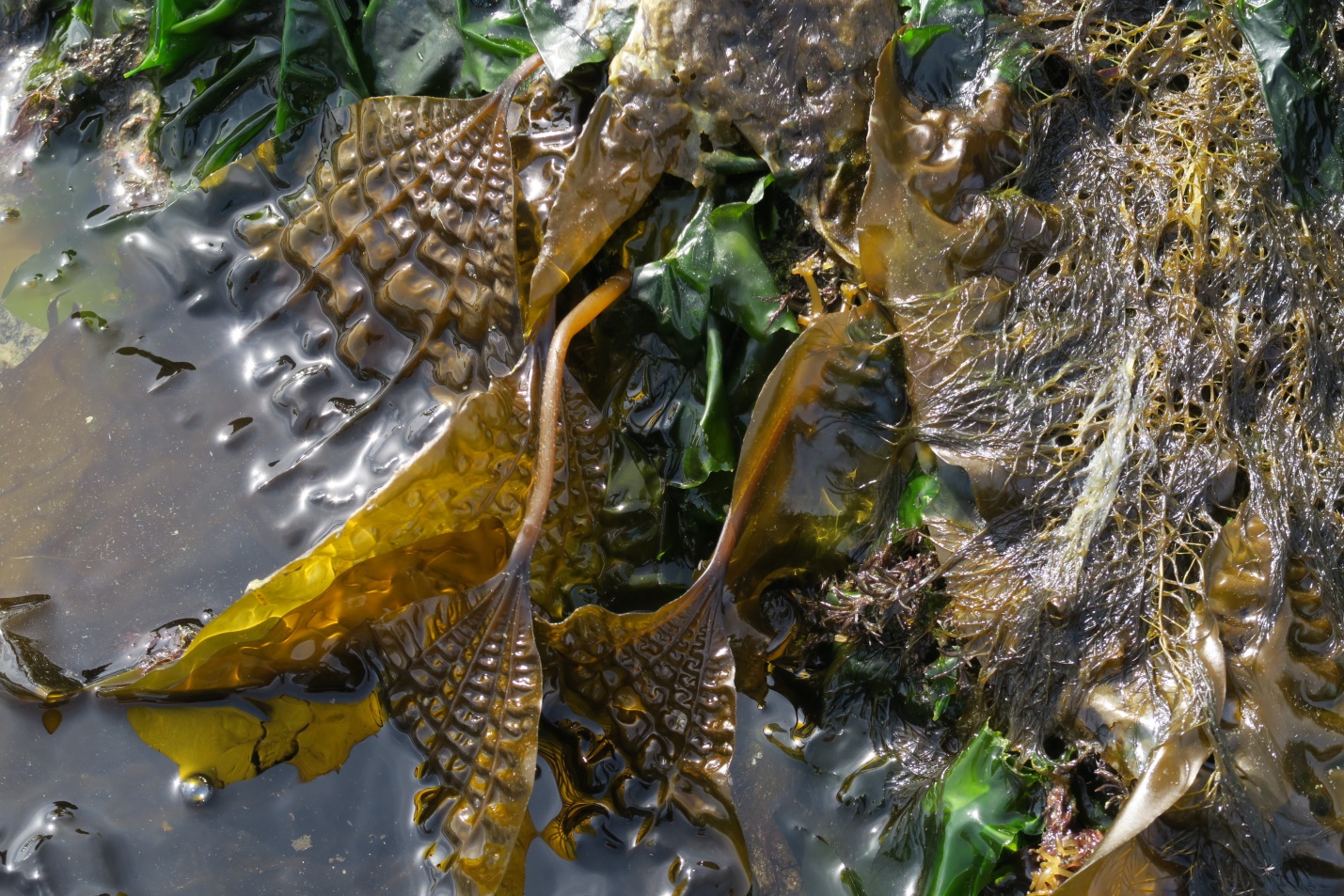
Figure 1: Costaria costata, common name Five-ribbed Kelp or Seersucker Kelp – several younger plants growing from the bedrock outcrops at Gonzales Bay, Juan de Fuca Strait, BC, Canada. April 2, 2021. Photo ID 27152 ©Seaweedwhisperings.com
In situ observations:
All observations were done in-situ. We interacted with several live individuals in the low intertidal zone; the seashore here is a jumble of sand, mud, gravel, rock and granite outcrops.
My stuff…, or not?
This is an old friend; a favorite seaweed of mine.
Always brings a smile to my face when I encounter it.
Costaria costata was on my first list of seaweeds to consider interacting with more closely.
Frays and tears very easily at ends, but not so much along the edges.
Holdfasts seem to always be covered by other seaweeds. Secrets obscured?
Gorgeous symmetrical rib pattern on the blade, particularly beautifully where the ribs diverge from the stipe.
Holdfast small and conspicuously branched.
Very thin blade with a slight gelatinous feel.
The holdfast dislodged easily when I tugged the seaweed lightly. Obviously it’s not well-anchored!
Stipe somewhat flattened.
Somewhat sweet lettuce-y taste.
The pleasant taste lingers, no bitterness or strong aftertaste.
The blade of the seaweed is thin enough that I can see my fingers through it.
I like running my fingers along the surface of the blade. I like the smoothness of the shallow bumps.
Smell is like the taste.
Looks symmetrical from a distance but up close it is “imperfect”.
This seaweed presents a façade of strength, properness and order.
Is its real self well hidden?
Costaria is showy, stands out amongst the other kelps.
The stipe is finely ribbed between the holdfast and blade.
The holdfasts’ branches are like the stumps of cut off fingers.
This seaweed is beautiful but not particularly lively or energetic.
Calm and peaceful energy came through during our observations, despite noise of chainsaw and screaming children nearby.
Person 2:
Young blades of Costaria costata are splayed out on rocky outcroppings on this breezy, sunny, spring afternoon. They are quite flattened and wilted looking in spite of the characteristic puckers and five ribs which can give such texture to the blade.
A few have significant discoloration/bleaching of color.
The holdfast is interesting. Some splayed out fingers have grasped the rock and are holding there; others radiate out a bit higher up and also reach to take hold, but haven’t yet. They appear like they’re “holding” only air.
Tangled amidst these tiers of holdfast ‘branches’ are other seaweeds. So many that you usually don’t see the holdfast at all as it is covered by Ulvas, Polysiphonias, Palmarias and other macroalgae.
A red rock crab just walked sideways by my feet – it startled me somewhat. I looked at it and it returned my gaze. I said, “Hello”, and then noticed it was injured, was missing its big front pincers. I felt a short moment of sadness for his loss, but then I saw he was growing two tiny new ones. Oh, good! Injury yes, but repair and recovery follow.
I now choose to move away from the younger Costaria plants on the exposed rocks to observe older Costaria costata plants underwater.
I observed, in a few different locations, that the larger Costarias were growing in groupings with other seaweed species, often Ulvas and Palmarias. So what was seen was a selection of the three main seaweed groups – brown (Costaria), red (Palmaria) and green (Ulva) all living in close proximity.
I spent some considerable time with a very big “old growth” blade. It is thicker and notably tougher though still tattered at the tip. The base of the broad blade fans out from the stipe, rounded and full and heart-shaped. The word generous comes to mind.
The stipe starts out roundish at the holdfast and quickly flattens like a thick, strong leather belt. It broadens to form the blade/leaf approximately 20cm from the holdfast. The five ribs of the blade grow on alternating sides. Three ribs are on top and two are below, or vice versa, depending on how you think!
Alternation – top side then underside, top side, then underside.
Between the ribs the ‘flesh’ of the blade balloons out, and on the other side, it appears as a pucker. This happens over and over between the parallel ribs, creating random and attractive patterns.
Touch – there is a rubbery texture to blade. It is also slippery and smooth, except of course, the puckers are not smooth when considered from the macro perspective.
On both sides, the outermost edge of blade is smooth and generous and gently ruffled.
Each plant needs some room.
It will share the rock with other species, but the big blade would shade out others of its same kind and so with the “old growth” individuals I don’t see groupings of Costarias. Younger ones do occur in small clusters, and maybe one by one they lose their associates. Thus the oldest ones become solitary.
Younger blades don’t have the heart shape – perhaps it is unusual for individuals to live long enough to attain that very mature form. The young blades are very slippery, smooth and translucent.
The blade stretches a bit then snaps; it tears in clean lines.
Taste – a full, salty celery taste with a slight iodine flavour – good; I quite liked it.
Watching the blades move with the gentle ocean swells today is calming and peaceful.
Blades move gently, wafting, folding gently back over themselves and then unfolding again.
Movement is smooth and flowing.
Silt collects in the puckers. Does that annoy? I think it does.
Olive/brown/green color. Uniform coloration except the ribs. The silt detracts and mars one from seeing the beauty of the color variations made manifest by the bullate nature of the blade and the play of light and shadow therein.
The ribs stand out, lighter colored yellowish parallel lines against the darker background.
You have a “presence”. Your size is part of it, your patterning, too.
And your energy is like a gentle giant.
You want to harm no one.
You do want to prosper, but you don’t need to dominate.
You enjoy sharing and helping others, especially in “getting started”.
It gives you pleasure to see others do well, to thrive.
Once established you are secure enough in knowing that your way works for you that you seem to enjoy, perhaps even require, differences/diversity – size, shape, color, mode of work.
The look of the patterning of the blades is reminiscent of alligator skin, sea turtle patterns, certainly reptilian.
You do have an “elder” energy. Or an energy of one who remembers their roots – and those roots go far back to something almost prehistoric.
What a success story – all those generations and here you are – still gently, generously, heart-fully alive.
The holdfast of this seaweed does not look so robustly secure.
In the younger plants, I see holdfasts that are intertwined; are they helping each other? Or are they too intermeshed?
I enjoy moving my fingers over the blade underwater – it’s a pleasant feel, smooth but also bumpy – entertaining.
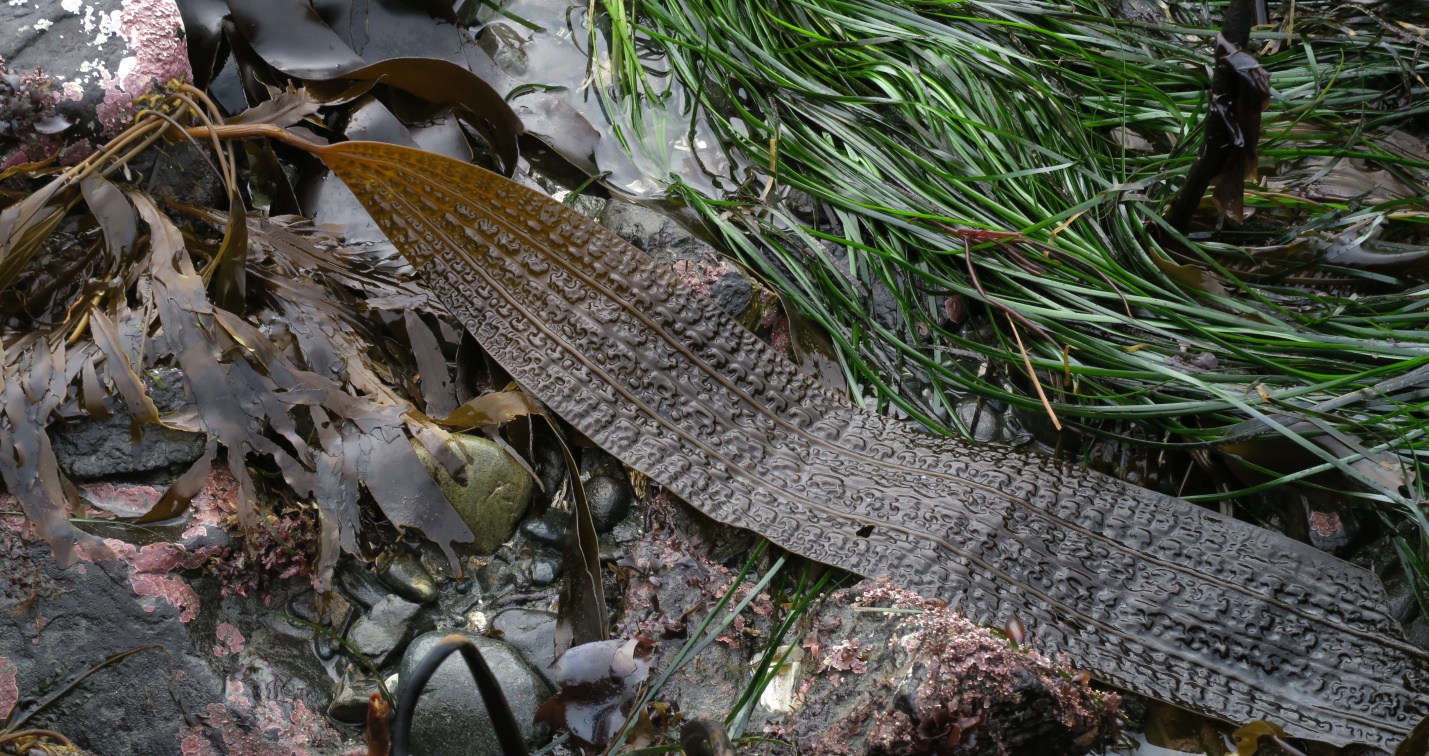
Figure 2: Costaria costata, Five-ribbed/Seersucker Kelp – this blade is over 2 meters long and is comparatively narrow. Individuals inhabiting rocky shores exposed to high surf tend to grow in this elongated form, whereas the broader form is typical of more sheltered habitats. Fishboat Bay, Juan de Fuca Strait, BC, Canada. June 8, 2020. Photo ID 27153 ©Seaweedwhisperings.com
Further Observations & Impressions:
After our first review of our in-situ field notes, it seemed that our observations seemed quite different from each other. One reason for this may be because one of us was mainly working with young individuals, and one of us was mainly working with very mature ones. Person 2 deliberately chose to leave Person 1 with the “babies”, and went to “talk with” the elders.
Is it true that not many plants live to reach very old age?
The more experienced seem to want to impart wisdom and “a helping hand” to youth. They do so not by saying, “Here, I’ll give you ten thousand dollars for college fees”, but rather by saying “if you’d like, I’m willing to be your mentor”.
There is a theme of liking diversity that was seen by how this seaweed can easily coexist with very different species.
It brought to mind the idea of students who want to study at international colleges that have an enrollment from many countries, or of a Caucasian person teaching in Japan, or in Kenya, or in Mexico – where your appearance and culture are obviously different, but you are nevertheless very comfortable and enjoy being there and being different. Being different is really not even thought about. The energy is not of one trying to be an “example” or “icon world citizen” or a “poster child” aid worker, it’s simply an expression of their nature that they do well on their own (distant from their native culture) and they are interested in and interact very well with diverse others.
This is parallel to the elder imparting information and experience to the younger.
Parallel. The word is notable for this seaweed.
There are five parallel ribs that easily distinguish this seaweed from other kelps.
Parallel. This is also the desire for others to do well along side of you.
Parallel. One line does not overtake or assimilate the other.
Two ribs on top and three ribs below, or two ribs below and three on top? This kelp blade, with its ribs and puckers/seersuckers between them, appears to have no right side and no wrong side. It is true that almost all seaweeds share that feature. Unlike land plants which have a side of their foliage that faces the sun and an underside that does not, most seaweeds have ‘sides’ that are alike. I wonder if the recognition of this feature of marine algae came while interacting with this particular seaweed, Costaria costata, because they have an innate freedom from “sided-ness”, from bias and judgment.
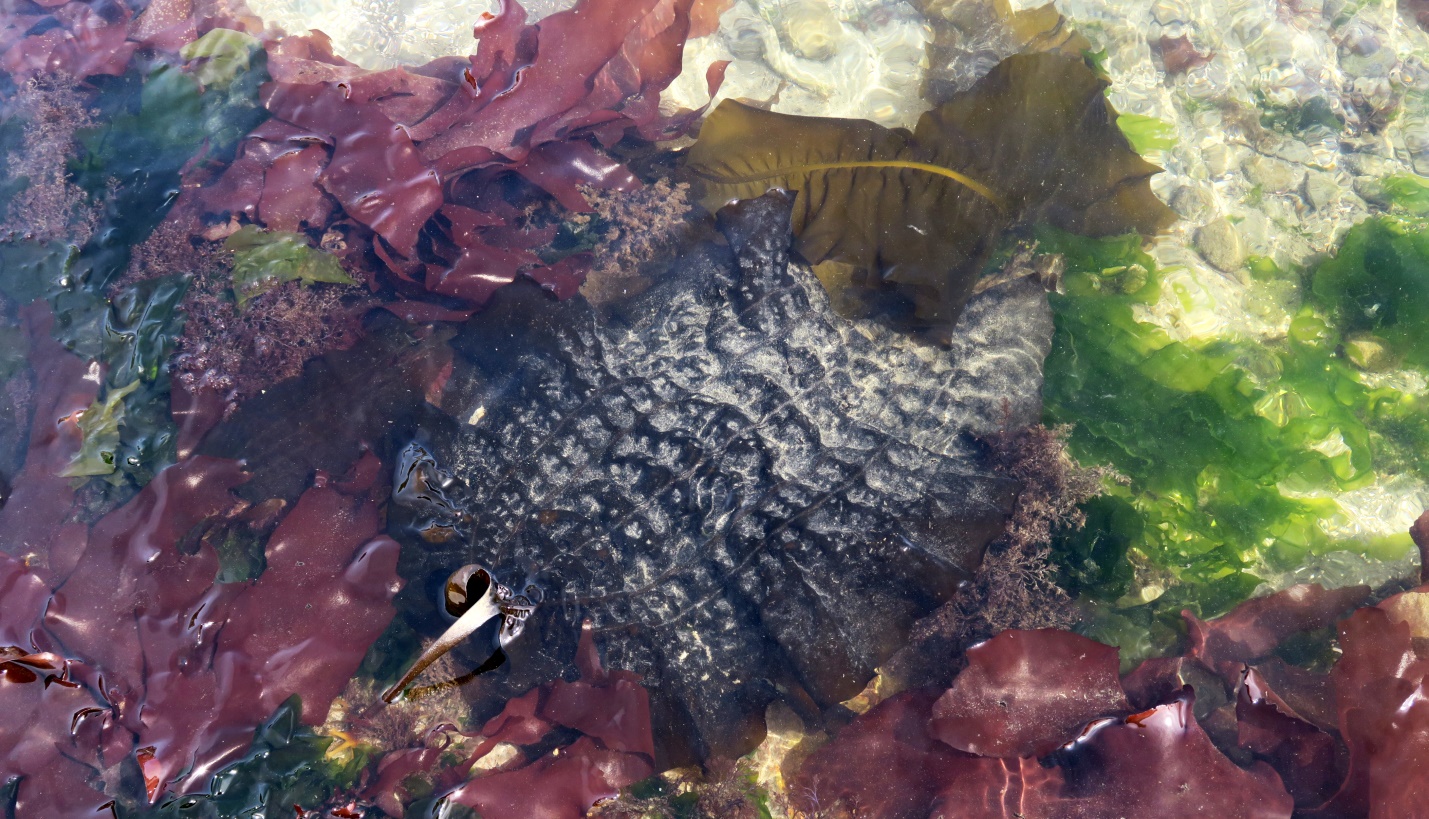
Figure 3: Costaria costata, an “old growth” individual growing with Alaria marginata, Palmaria mollis and Ulva fenestrata. Costaria is typically an annual alga – it is uncommon to see such ‘grandfatherly’ individuals. Living in a more wave sheltered area, this blade grew to be very broad. Gonzales Bay, Juan de Fuca Strait, BC, Canada. April 2, 2021. Photo ID 27154 ©Seaweedwhisperings.com
Person 1:
“Seersucker” – classic material for a well-dressed gentleman in summer.
“Five-ribbed Kelp” – simple description of its appearance.
“Costaria costata” – ribbed and more ribbed. Ribbed – as in “made fun of”?
Person 2:
“Costaria” – apart from the Latin origins meaning “rib”, I think there is something notable to the sound and the simple meaning of the word within both Costaria and costata, “cost”. There’s a feeling to me in this name of one who weighs costs…, who’s conscious of them, and wants to steer clear of the edges.
“Costata” – like saying the same thing two ways; in Costaria there was weighing costs, and in costata there is a ‘foreign’ or ‘different’ ending and that reflects some of the happy to exist in other cultures energy we experienced.
“Five-ribbed” – an obvious feature of the seaweed’s morphology and one that makes it easy to identify. I wonder if there are any animals with five ribs? I think it is vertebrates that have ribs and that means animals with a backbone. Is the rib “named” in this kelp, but the backbone understated?
“Seersucker” Kelp – seersucker fabric has this same look; I wonder if the fabric makers got the idea from seaweeds? Also, seersucker fabric is often striped, and that would have the same look as Costaria – the ribs are the stripes and the puckers between are the seersucker.
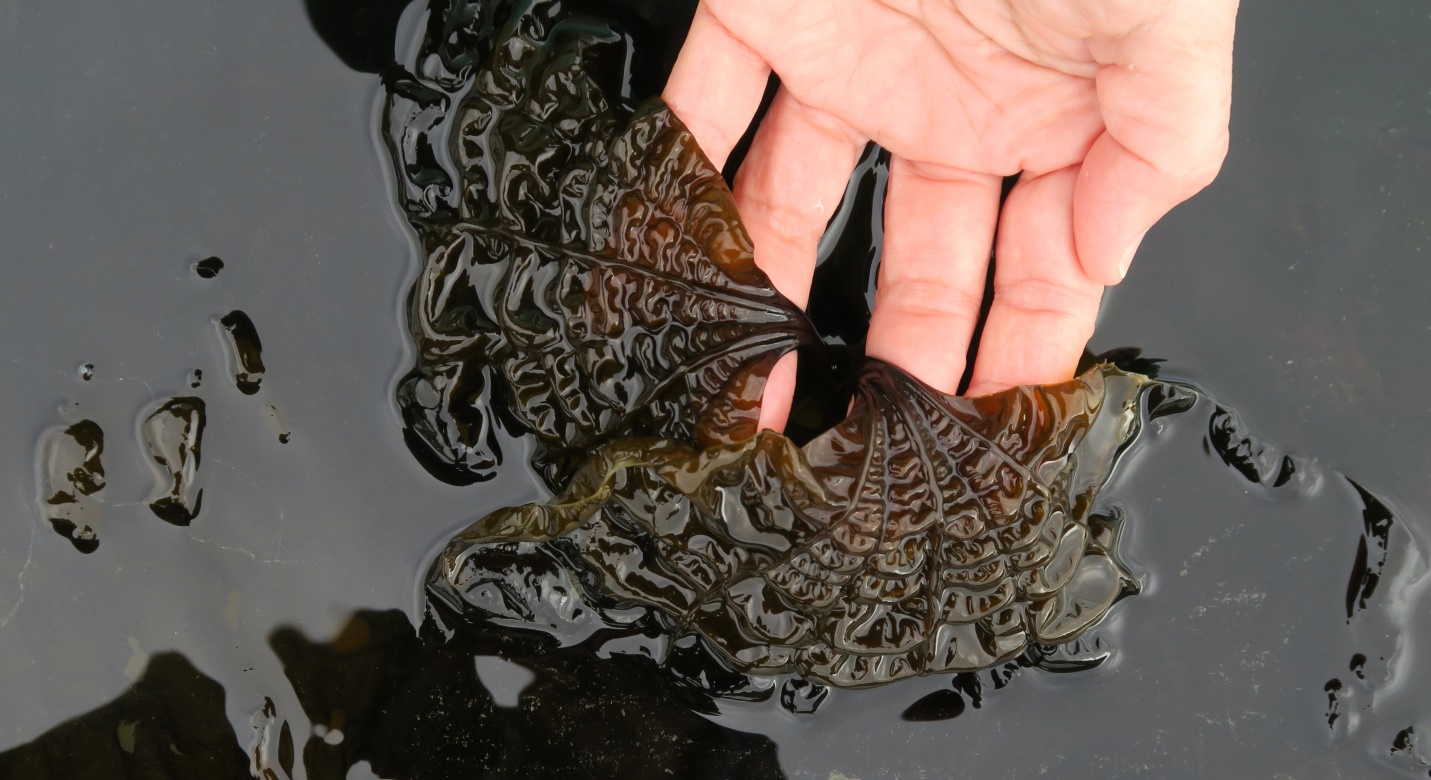
Figure 4: Costaria costata – the base of two young blades are held above the water to display the ‘point of convergence’ of the five ribs and the patterned bullate surface of this alga. Gonzales Bay, Juan de Fuca Strait, BC, Canada. April 3, 2021. Photo ID 27155 ©Seaweedwhisperings.com
Discussion:
“My stuff or not?”, Person 1 asked. Intertwined, questioning, seeking to understand – these themes are evident.
Old friend brings a smile to one’s face – gentle in relationships, truly friendly without agenda.
Frays and tears at ends – leading/growing/distal tip is vulnerable.
This feels like it might be related to the generosity concept. If you become over-generous, perhaps you gave away too much of your time or money. You may eventually realize you should have kept some for your own well-being, but it’s too late, you’ve become exhausted and somewhat beaten or scarred (tattered tips) because you were giving so much. It’s in good shape until it essentially goes too far.
New/young = tender and vulnerable
Seasoned/old = tough and weathered (life experience shows)
Beauty – the beauty Person 1 first identified with is fresh and innocent; it is soft, innocent, at the point of ribs diverging where it is just emerging, so has not yet been damaged. Like a fresh green tree leaf in spring that no caterpillar has had a chance to take a bite from and no wind has torn or toughened yet. Fresh, innocent and beautiful.
Secrets obscured? There’s this showy piece (the blade), but there’s also a hidden part (the holdfast) of their being that is out of sight and obscured. And it is obscured because they get involved with others.
The generosity is easily noticed by others; it is obvious. Many people can come to interact with Costaria because they are attracted to this quality, and they don’t look to see beyond the generous nature, to notice anything more about the Costaria individual beyond that obvious quality. So for two reasons – one having parts of one’s self covered and obscured, and two, having a strong positive feature that “steals the show” – these two aspects provide a convenient shield from outside scrutiny. Therefore Costaria can easily retain confidential and little-revealed aspects of their character.
Dislodged easily, not well anchored by its holdfast. And the blade is big, broad, generous, striking – this is the part between the holdfast and the tip. It can thrive in “the middle” and at the start (holdfast) and the finish (distal tip), the two ends, this seaweed can be damaged or it is very weak.
It can thrive when in the middle. It doesn’t want to be the star but it does want to be recognized and often is rather outstanding.
Thrives in the middle – this implies there are others around them… and they can work well in groups. And they see themselves as, and like to be strong contributors to the group.
In the middle of…, but not in the middle of others of their own species.
Maybe they thrive better outside their natal circles, with other species, other cultures?
Sweet, pleasant, no bitterness or aftertaste – this is indicative of an energy most others would like to interact with and who doesn’t hold grudges or generate ill will. And it’s also not sickly “sweet” or gushy; it’s not overstated friendliness. Likeable, smooth relations are the norm.
They can take care of themselves, dress nicely, not overdone but they like to be well-groomed and have a sartorial distinction. Unlike when encountering someone who is really weirdly dressed or smelly (perfumed or in need of bathing), when you meet Costaria you have no hesitation to interact. Their appearance puts you at ease and evokes some admiration, too.
They may not be aware of what lies within themselves – their nice dressing (with their knobby toes neatly covered), their helpful and generous contributions in groups and their considerable energy poured into projects they undertake – all these things shield others from seeing the less perfect aspects of Costaria costata and also trick/distract Costaria from knowing themselves in a more complete way.
In spite of their sartorial inclinations, there often is little need for it! Costaria, in good to fine health, is showy and can stand out, but is not flamboyant – Costaria doesn’t strive to be showy, it somehow just is rather outstanding. The showy-ness is an innate, deeper beauty.
Patterns to the puckers of the “bullate” leaf (puckered and blistered; segmented valleys and ridges) are varied.
One Costaria blade had a pucker that gave the distinct impression of a ships anchor. Along with that visual we have the understanding that the whole plant can, at times, be poorly anchored. On the flip side, the Costaria personality often seems to be, within their group of involvement/interest, an anchor for others.
Person 1 noted that the Costaria individual he had accidentally dislodged came up as a whole, not at all broken. He had the feeling that if left in the water, the seaweed may have at least the chance to relocate, re-establish and not die. Possibly those knobby, splayed projections at the ends of the holdfast could snag a new base – like a grappling anchor? Also other seaweeds could be attracted to settle on the Costaria holdfast protrusions and potentially help re-anchor Costaria.
Not particularly lively or bustling with activity, the energy of Costaria is calm and peaceful to be around. That is how it reliably feels to be near Costaria. Deeper within, though, we have the full range of human emotion – their inner energy is not on display.
Gentle giant, they’re aware they can be “big” compared to others, so they innately tone down their inner feelings and reveal them in gentle ways most of the time. They can be very tolerant and mindful of others and – they would “fold over on themselves” rather than see someone else uncomfortable or compromised.
Most of their life is devoted to what they do with their groups, so there isn’t much left, much time left to be introspective. So you’re not likely to get to a stage of complaining about others or recognizing your own foibles, because, well, you’ve put in a very long day and it’s time to go to bed. Instead of thinking of your inner self, you’re thinking about the events that just happened or the ones just about to.
Injury, repair, recovery, carry on. Life experience and resilience shows.
In-situ, Person 2 deliberately made a choice “to move away”. This reflects the Costaria preference to work with different people, to relocate to a notably different cultural setting. And the idea about the ribs, of two on top and three below or three below and two on top – it all depends on how you think. We feel that there is a genuine curiosity and openness to different perspectives in this seaweed’s energy.
Its nature is smooth and slippery. This can link to the hidden quality, for example if asked a pointed question they may be evasive in responding. This “slipperiness” can also be related to the reality that they may not actually know themselves clearly enough to deal with such incisive examinations.
Ancestry, roots, prehistoric – Costaria may not be aware of this history, but they epitomize it. They are resilient and adaptable. There’s a pattern of living competently in the present; the knowledge acquired through their ancestry is simply and appropriately embodied.
There is a “reptilian” look to this alga’s blades and this look is displaying the attractive side of “reptile” as opposed to the repulsive or scary side. In another energy type, this quality could be put to use delivering a positive “spin” to anything, but in Costaria it’s a genuine presentation of the “best”; this possibly could slip into a type of deception, but it mostly feels like it is used as a protection and a hopeful representation. There is a vulnerability that the fine dressing and gentle friendly demeanor shields. In fact, the overall shape of a mature blade is very much like a medieval knight’s shield.
What is success – in this seaweed, success best comes not as an outright objective or goal, but as the natural outcome to its innate adaptability, its ability for hard work and its cooperative character.
Holdfast not totally secure – do they rely on the help of others?
It’s not that they’re relying on the others; it’s that while they are growing more branches to strengthen their own holdfast, they are not only tolerant but encouraging of others to be growing too. And that can mean their own anchoring may be compromised – suddenly there’s an Ulva and a couple Palmarias between them and the rock now!
Interesting side point to that, because they move well amongst the group, they can work around the obstacle if they have suitable time and conditions, just as Costaria the alga may reach around other seaweeds and find their anchor rock.
At times this association can yield a cooperative result, not just a problem, and the Costaria individual is helped in its own anchoring by the other species intermingled and is thus able to thrive.
Do they “need” others?
Yes, they need the energy or group dynamics, but they don’t need a certain individual’s help per se.
Social interactions – they’re sociable, and don’t get riled up easily nor become aggressive or confrontational; in fact, things mostly “slide off” of them like “water off a ducks’ back”.
Further to the “deliberately choosing to leave” aspect, consciously choosing new cultures and circumstances for living their life is the large scale expression. This can happen also multiple times in smaller ways in their life. For example at a social gathering they can decide to “leave” without making a big announcement, they may simply “ghost”. Silently, and without anyone noticing, they are gone.
There is a difference between young and more mature individuals. Is it that not many reach old, old age? Probably, yes. And, there is a desire to help out those younger or less experienced, as in being a wise and knowing mentor. To a younger individual, this Costaria individual has a huge reservoir of knowledge and experience that can be imparted.
Notable in this interaction and with these observations is that the “positives” of the energy came to us first, abundantly and with strength. The calm and peace of this energy is total calm and absolute peace.
We then opened our consideration/experience to the “negatives”.
It is difficult for them to enjoy/want to live with others of their own kind. It may be more difficult to stand out enough and be appreciated if they stay with their own kind. They also cannot see themselves very well amidst likes. And they themselves are more easily inspired to see where they can contribute when they are amongst those who are different.
The Costaria individual may at times find it difficult to live with themselves and this is partly because they don’t really want to look at themselves. If alone, particularly when young, they don’t want to look at their own way of being. Perhaps they try but easily become confused. What looks quite good on one side (of themselves), is on the reverse (viewed from the opposite perspective) really not very flattering. So they get nowhere with understanding themselves, they just get the confusion of never-ending flip sides. It is difficult to hold both extremes; do they not see that as the whole?
The frayed tips are an illustration of how this seaweed can become vulnerable when venturing out too far from the center, from being “in the middle”.
The frayed ends are also parallel to this flip, flip, flip component of their being. Because of that constant flipping, they can sink deeply into confusion and become weakened and vulnerable. Knowing what’s what is very difficult. This could result in them being unwittingly taken advantage of by others, or in more serious examples risking their own life or even ending their own life. The expression “still waters run deep” is appropriate – the waters can run very “deep” beneath the outer calm and peace of this seaweed energy.
The bullate surface of the blade is a physical representation of this concept. On one side there is an outward pucker, on the other side the pucker is indented. We have the “inverse” aspect. When we connected with the “deep” and darker energy of this seaweed we experienced the potential for fear, fear even at the level of terror – the total inverse to calm and peaceful.
The dark side of this seaweed’s energy is dramatically the inverse of its lighter energy – so much so that it is almost at the vanishing point; it is there, but it is held so far away it is nearly imperceptible.
The route “between” one polarity and the other, terror and peace, is a long journey, one not actually ventured without clear intention and considerable courage. It feels as if to even embark upon a few steps is risking being thrown into the abyss. The poles are so different that they almost create a magnetic pull – one that Costaria costata is challenged by all the time. When in harmony the energy of this seaweed embraces fear and calm, terror and peace as a totality.
As long as the energy of these deep emotions flows on through, the whole can be intact, but it seems that Costaria may fear what their ‘far reaches’ may reveal and therefore can’t confidently embrace it. The evidence of this struggle is plain to see in its almost always tattered tips.
Vanishing point has a synonym which is the point of convergence. In Costaria costata, the point of convergence is where the stipe fans out into the blade. This seaweed, at one place in its morphology, literally embodies “the point of convergence” – but once the blade’s parallel ribs develop, they never regain that convergence. That is the “abyss”; there is no way to return to that point, as is plainly seen in the physical expression of a living Costaria.
The Costaria energy somehow knows that they won’t ever come back to that beautiful point of convergence. Maybe this is another reason why they fold back upon themselves in their physical movement – to be closer to that place again.
A less “dark” negative is that there can be over involvement in possibly one or two endeavors. Perhaps they’re an active member of the local rhododendron society and not doing much else, or being an English teacher in a foreign culture and so fully absorbed in mentoring their students that there’s little time for anything else. They become so engrossed that they neglect other components of their life. This over-giving limits their growth, can lead to exhaustion, but does serve to distract them from awareness of the “abyss”.
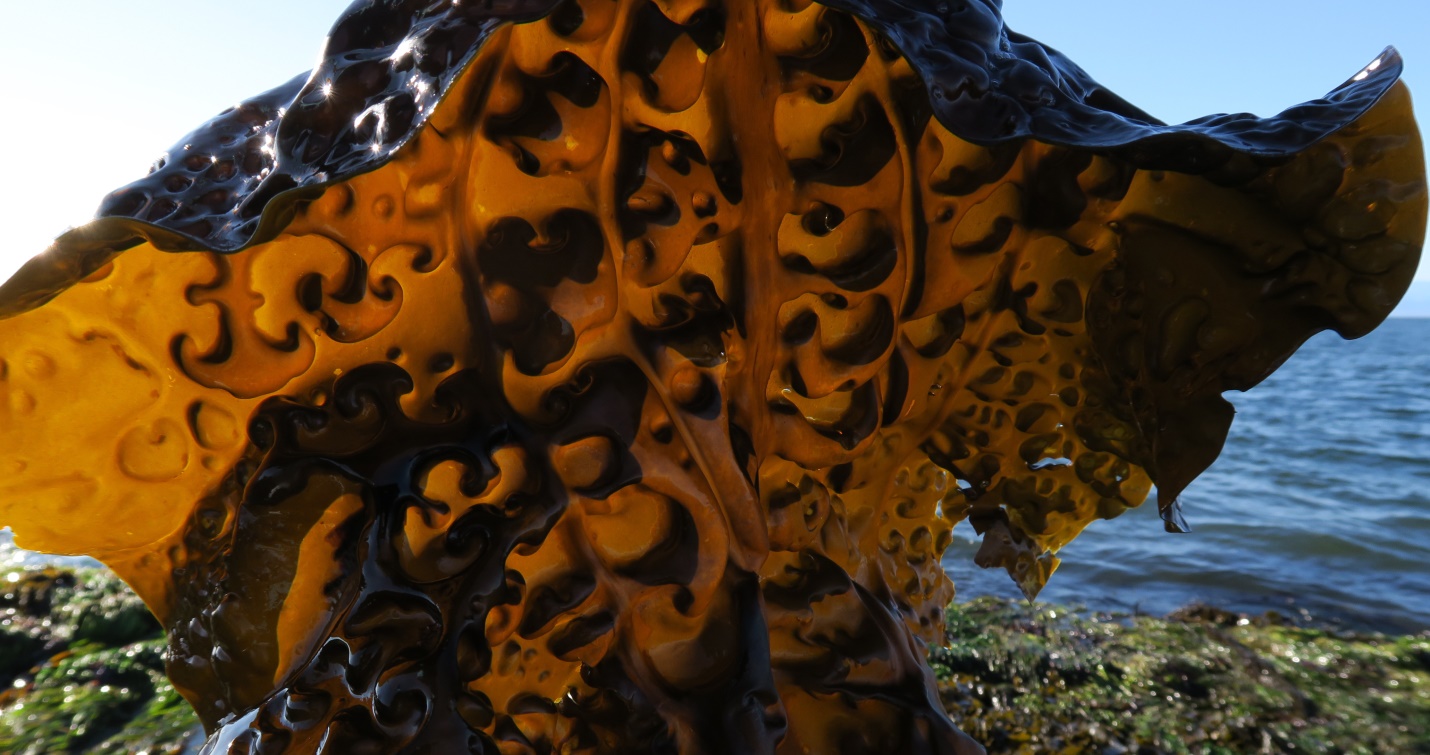
Figure 5: Costaria costata, Five-ribbed/Seersucker Kelp – washed ashore, this very large individual is held up to the light to show the striking patterns of its morphology. An “anchor” is revealed in the upper left portion as is the “depths of darkness” in other areas. Harling Point, Juan de Fuca Strait, BC, Canada. August 17, 2020. Photo ID 27156 ©Seaweedwhisperings.com
A Dream Arrived to Sum Things Up:
A recurring dream last night:
We had acquired a rather messy looking plant, and I was looking at the buds to make sure that they were coming out ok and discovered that there were two chameleons and three other long tailed lizards in this plant or on the ground at the base of it. I was wondering how we were going to take care of these lizards, and what they needed to eat. I really hadn’t intended to acquire any pets. Then I thought, wait a sec, maybe it’s a whole ecosystem!
Still in the energy of the Costaria costata interaction, we looked to see the message of this dream. We saw that it is:
About the whole, being able to encompass things as a whole.
And that we don’t have to take care of everything, there’s a bigger……plan afoot, a wiser and far more encompassing ‘order’. Each plant and critter has ways of thriving and taking care of itself. And maybe humans need to pull back on thinking that we can appropriately care for these other living things directly. What we need to do is care for ourselves appropriately by recognizing and resuming our place within the whole of life.
We’re only supposed to do jobs that we’re equipped/trained to do. Doing things outside your abilities leads to problems.
The plant in the dream was “messy looking”…, and we considered that aspect. A few more details were that there were shriveled up parts of the plant down near the ground, and some dead twigs and leaves, that had possibly died back when shaded out by newer growth. So, this plant hadn’t been “cared for”, it was doing its thing as it should; leaf litter and other debris collected at the base. Allowing this to occur as it naturally does, created homes for other animals to live in and around this plant. Metaphorically, there was a suitable setting for ideas to flourish.
This reminds us of the desire Costaria costata has to do no harm to others. How they will hold back certain emotions due to concern of how others will be impacted. It occurred to us that it is in this kind of “taking care” that we can actually do harm…, we are blocking the fundamental action/reaction expressions of life and these are the lessons that naturally teach us the adaptations we need to make in order to grow suitably and to thrive within our circumstances.
In this seaweed it’s such a range – from terror to peace. And one key concept is avoidance. Avoidance of knowing the full extent and depth of the darker/shadow side of humanity – conflict, jealousy, hatred, vengeance, violence, shame, rage. This avoidance is stronger in Costaria than in other seaweeds we’ve interacted with.
They don’t want to even look, and do most anything to avoid exploring the dark side. They keep smiling, get busier with their groups, and maintain that calm and friendly seeing-the-positive-in-everyone demeanor.
There is a cost to that, other than not getting to really grow, and the obvious one that could be commonly seen is burn out. The deeper cost with the unexamined issues is that there is, with every denial of that darker side a further tattering of the leaf tips, a postponed appointment with one’s own ‘daemons’. The constant avoidance and putting off makes this seem increasingly weighty to fathom. If Costaria can go with the ‘flip side’ of avoidance and truly engage, the result certainly would be fuller self-awareness and deeper connectedness.
The energy of a Costaria individual can be quite sought after by others – around them the world seems to be in order and one feels calmer and more peaceful – the feeling is, “all is good”.
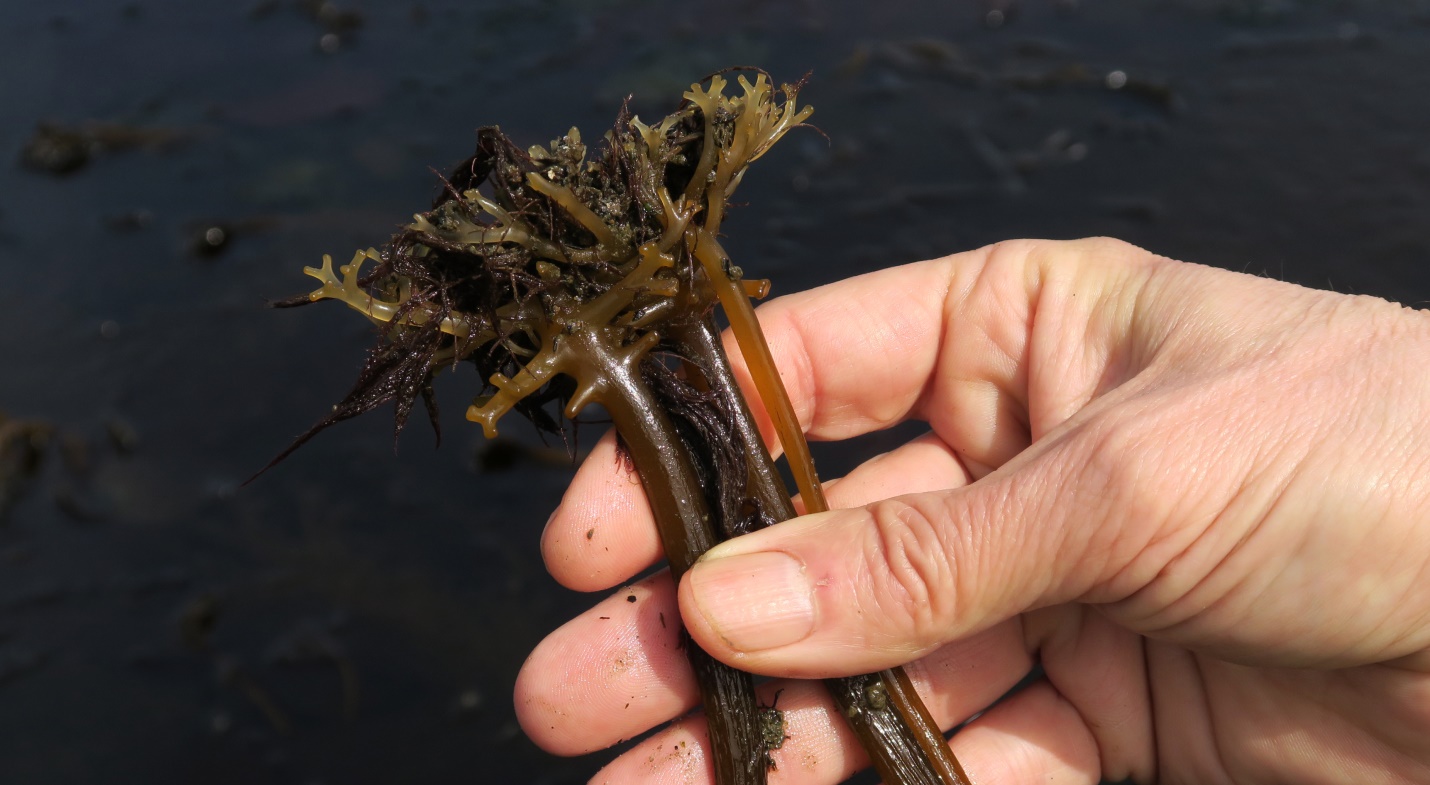
Figure 6: Costaria costata, Five-ribbed/Seersucker Kelp – close view of the intertwined holdfasts (along with some Polysiphonia stems) of three young algae. Gonzales Bay, Juan de Fuca Strait, BC, Canada. April 2, 2021. Photo ID 27157 ©Seaweedwhisperings.com
Biology & Natural History Information:
Habitat:
This annual kelp is found on rock and in the low intertidal to upper subtidal from semi-protected to semi-exposed habitats.
Description:
A profusely branched holdfast anchors this species to rocks. A single rather flattened stipe of up to 2cm wide and of variable length (up to 65cm) is finely grooved with longitudinal striations. This stipe supports a single yellowish-brown to chocolate-brown undivided elliptical blade which is from 50 to 250 cm long and from 10 to 35 cm wide. The blade carries five or seven parallel ribs running its length. No other local alga has this distinctive feature and these ribs project alternately above and below the surface of the glade. The blade is profusely wrinkled or puckered between these ribs; hence the common name since it resembles seersucker fabric.
This species is usually an annual but in some areas, it can be perennial. Blades reach their peak of development in mid-spring and within a month they are tattered and sickly looking and definitely past their prime for the season. Similar to other kelps, new growth in the blade arises where the stipe widens out into the blade – at the base of the blade; so the tattered ends are the oldest parts of Costaria costata’s thallus.
The species is low in caloric value (2.94 Calories per gram of dry weight). Common inshore and in outer coast waters, sea urchins are among its most important grazers.
Costaria takes a remarkable range of shapes based on environmental differences, most commonly the morphology reflects the degree of wave exposure it encounters. In high wave exposed sites individuals are narrow and thick and their stipes are ridged and a series of regular perforations run the length of the blade. Wave sheltered individuals are broad and thinner, with smoother stipes and no perforations.
World Distribution: Unalaska Island, Alaska to southern California; Korea, northern Japan; Russia.
Classification:
Phylum: Ochrophyta
Class: Phaeophyceae
Order: Laminariales
Family: Agaraceae
Genus: Costaria
Species: Costaria costata (C.Agardh) De A.Saunders 1895
Previous names: Laminaria costata C.Agardh 1817 and Agarum costatum (C.Agardh) Dumortier 1822
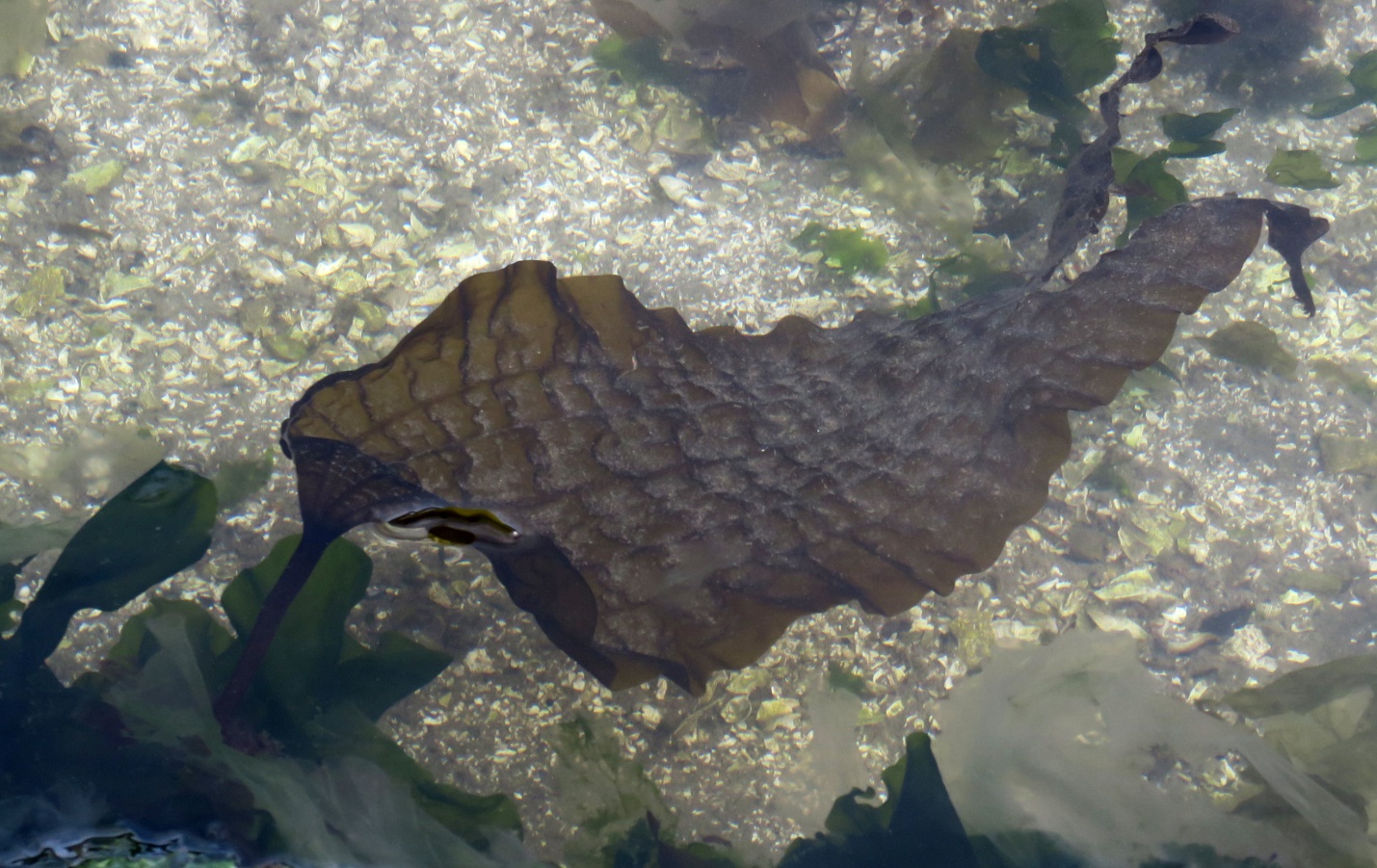
Figure 7: Costaria costata, Five-ribbed/Seersucker Kelp – a large blade afloat at Gonzales Bay. The puckers are filled with sand and silt and the tip of the blade is ripped quite deeply. In this frame if you look near the stipe you can see the beginning of the ‘folding over’ movement that is characteristic to these blades. Juan de Fuca Strait, BC, Canada. April 3, 2021. Photo ID 27158 ©Seaweedwhisperings.com
![]()